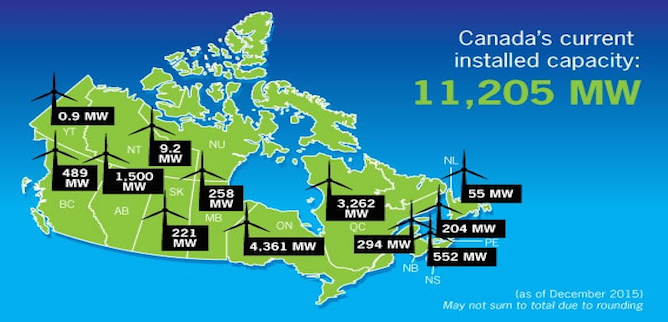The following is a guest post from CanWEA, the Canadian Wind Energy Association, is the voice of Canada’s wind energy industry, actively promoting the responsible and sustainable growth of wind energy. CanWEA believes that the federal government has an important leadership role to play in creating the policy frameworks that will determine how Canada cleans and modernizes its electricity grid and energy systems, and to create a national climate strategy to address climate change. In this article, CanWEA has put forward 7 key recommendations on how the federal government can support increased deployment of wind energy in Canada:
Federal budget has a role to play in ensuring climate action
Wind energy is one of the most environmentally-friendly forms of electricity generation. It is cost-competitive with all other sources of new generation and its costs continue to fall. It is a key element of any credible plan to address climate change.
CanWEA believes the federal government can support increased deployment of wind energy and other renewable energy in Canada by:
- Ensuring carbon is priced across Canada: CanWEA believes that carbon should be priced in all regions of Carbon pricing is widely considered to be the most economically-efficient policy to ensure economy-wide greenhouse gas emission reductions. A meaningful carbon price will help level the playing field between greenhouse gas emitting sources of power and renewable energy. To be effective, any price on carbon will need to be meaningful, transparent and escalate in a predicable manner. Revenues should be near-neutral so that budgets are not balanced on the basis of carbon price income, with a portion of revenue dedicated to modest investments in additional greenhouse gas mitigation.
- Implementing a clean-energy enabling carbon standard for natural gas-fired power: Environment Canada has already regulated coal-fired greenhouse gas emissions to a maximum emissions rate of 420 kg/MWh for any units that reach a maximum of 50 years of life, or any new units built after 2015 (emissions from existing units are in the ~1,000 kg/MWh range). The federal government is likely to introduce natural gas regulations that would be equivalent to the 420 kg/MWh limit. This is, however, close to business-as-usual for any modern gas plant operating at commercial efficiencies, and will not likely result in any significant greenhouse gas emissions reductions. A more progressive approach would require natural gas plants to also make reductions in greenhouse gas emissions over time, paired with sufficient flexibility to allow operators to meet more stringent standards. For example, generators could be allowed to apply the standard across a fleet (as opposed to plant by plant), as well as to generate offsets through new renewable energy projects. This approach would ensure that natural gas is an enabling technology for more renewable energy and not a barrier to more renewable energy. Furthermore, it would ensure long-term and permanent greenhouse gas reductions as more carbon-free technologies like wind are integrated into electricity grids across the country. Massachusetts has already pioneered such an
- Issuing renewable energy bonds: While many renewable energy technologies are cost competitive, particularly wind energy, the capital intensive nature of the costs to develop such technologies can be commercially challenging. A government-backed financing option for renewable energy projects that would be available for up to 50 per cent of project debt financing and administered by commercial lenders would address this challenge. Green bonds would be capitalized by ordinary Canadians who choose to invest in a relatively low but guaranteed rate of return. The bonds are used to provide both accessible, as well as relatively low-interest, capital that would be dedicated to green energy projects. This would help overcome financing barriers, as well as provide lower delivered energy costs to consumers by reducing debt servicing costs. Bonds are still expected to deliver a modest return and so at least 50 per cent of debt would be required to be leveraged from traditional sources to ensure projects are sound Successful precedents for green bonds exist in Europe and have recently been pioneered in Ontario with respect to transit… Read more on CanWEA’s website
Header Image Source: CanWEA website

